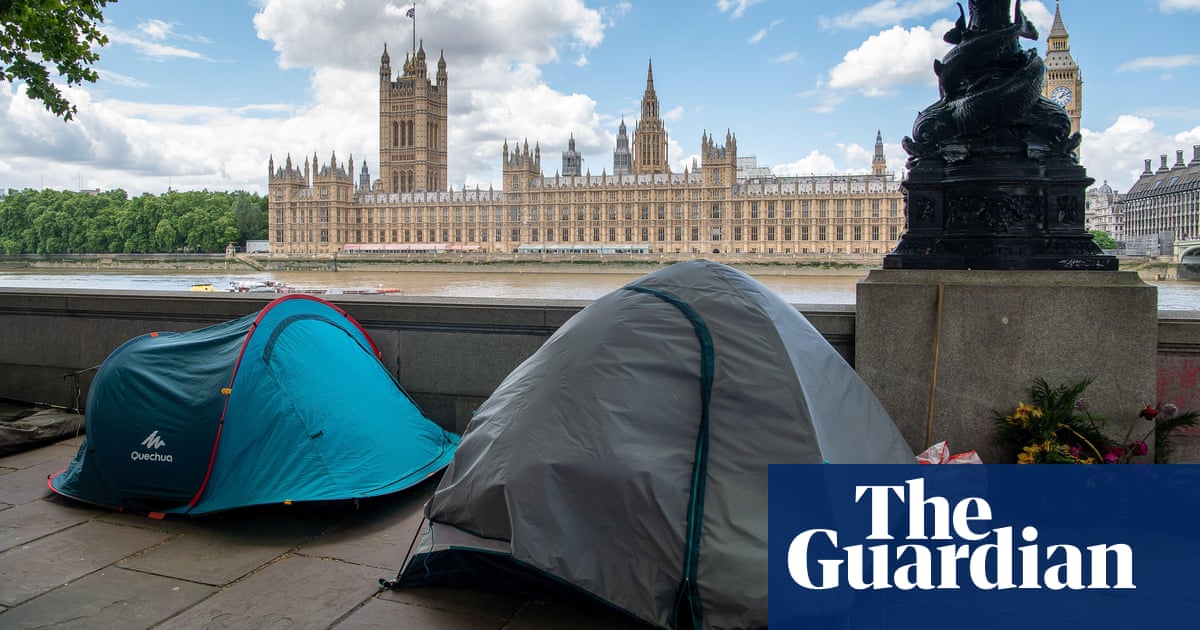
Jez Butterworth’s Jerusalem is back, 13 years and, as one fellow theatregoer put it on Wednesday, several culture wars since its premiere. Set on a riotous St George’s Day in a Wiltshire village, the day the functionaries of Kennet and Avon council have chosen to evict the defiant “Rooster” Byron from his illegal encampment, the play still pulsates with a punkish, Puckish energy. The company, less white as a group than in 2009, is still seamless; Mark Rylance still mesmerising. It remains one of the most brilliant things I’ve seen at the theatre.
Butterworth has recently disavowed the notion of having created a “state of the nation” play – which would anyway be a remarkably pompous thing to set out to do. That doesn’t mean he didn’t actually write one. What are artists for if not to sense vibrations undetectable by others? Great artists are the nation’s diviners and soothsayers. Currents rise through them, poetically, obliquely, while they are telling themselves they are dealing with the practical craft of making a workable script. Butterworth has boiled Jerusalem down to being a play “about wanting to stay but having to go” – and no, that’s not a veiled reference to Brexit. It is, at its most basic, about characters moving on or offstage, the most fundamental engine-work of drama since Clytemnestra persuaded Agamemnon to step on the purple tapestries at the premiere of The Oresteia in 458BCE.
I remember the shock of seeing Jerusalem in 2010: the absolute jolt of a new play about rural England – and you didn’t hear much about “England” as a cultural or political unit then. It wasn’t some pleasant pastoral; it was a difficult, messed-up countryside, albeit steeped in beauty and myth. Ultz, the designer, had conjured trees, thickets, grass; a clutter of old drinks cans and rubbish. Nothing about this was “cool”, nor was it “experimental”: it was a three-act play set over a single day, as a Greek might have done it, full of Falstaffian energies – which admittedly are themselves the energies of the counterculture, of punk, of an anarchic Englishness, both attractive and rebarbative. My mind couldn’t help flying to other darkly enchanted forests: Arden, of course, and the “wood near Athens” of A Midsummer Night’s Dream. The man was riffing with Shakespeare, with Blake. The confidence of it was jaw-dropping.
What’s difficult to remember is that for the preceding decade, while Butterworth had been holed up at home in Pewsey, Wiltshire, trying to get the play to work, the prevailing cultural tides had seemed so different. The focus had been on London and its resurgent inner city, fuelled by a rising economy. The capital – and this really does seem like something from another life – was full of cheap abandoned warehouses where the YBAs, still actually young, were setting up studios.
I was 24 and working at Condé Nast when the March 1997 edition of Vanity Fair was dumped on my desk – the famous “London swings” issue, with Patsy Kensit and Liam Gallagher reclining on union jack pillows. Inside, Tony Blair, two months off becoming PM, was photographed like a grinning young saint. Even at the time, though, there was a “this can’t last” feel: the cover article made much of echoes between its own moment and “Swinging London 1.0”, the dead-and-buried 1960s. I was working at The World of Interiors magazine at the time. In that venerable home of French ticking and toile de jouy, our January issue had been – shockingly in its own way – devoted to concrete. That’s where the buzz was: concrete and steel, Hoxton and Shoreditch. It was Damien Hirst, Alexander McQueen, Sarah Kane, the River Café. The buzz was not in Wootton Bassett, in Devizes, in Wilcot or Potterne, the English placenames Butterworth would conjure like charms. (All Britain came to hear of Wootton Bassett, mind, it being the place to which the bodies of British soldiers killed in Afghanistan were flown.)
When did things begin to shift? It’s tempting to declare that Jerusalem marked the end of the New Labour aesthetic, but that’s way too pompous. Anyway, things had gone sour long before: Iraq, the financial crisis. Lucy Prebble’s play Enron also premiered in 2009, though Jerusalem too contains a hilarious exegesis of What Went Wrong With the Economy, via a botched attempt to buy a gram of whizz. There were other artists working against the current: Jeremy Deller and Alan Kane were collecting their Folk Archive, including images of Cumberland wrestlers and Devonian tar-barrel rollers – exactly the sorts who might have done a turn at the Flintock fair, the village festival in Jerusalem. “The new nature writing” was getting going thanks to people like Kathleen Jamie and Robert Macfarlane. Foundations were being laid that would later, indirectly, give rise to artworks from Max Porter’s novel Lanny to Charlotte Prodger’s film BRIDGIT and PJ Harvey’s Dorset-dialect poetry collection, Orlam.
It would be facile to declare Jerusalem the prophet of Brexit. That would reduce the play. Jerusalem comes out of something more fundamental: a seam of rough, sometimes unpleasant English magic that churns away beneath the surface. It’s in Geoffrey of Monmouth. It’s in Shakespeare and Blake. It’s in Jacquetta Hawkes’s A Land. It’s in Alan Garner and Susan Cooper; it’s in Sylvia Townsend Warner’s novel Lolly Willowes; Deller would say it was there in 90s rave culture. Perhaps, though, Jerusalem goes deeper than that, to a place well beyond “nation” or “myth”, to the secret places of the imagination – where even the most rational raise spirits and commune with ghosts. “Come, you battalions … Come, you giants!”
Charlotte Higgins is the Guardian’s chief culture writer












